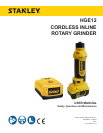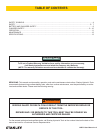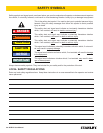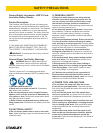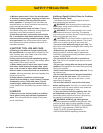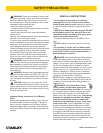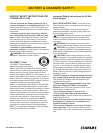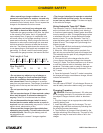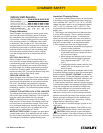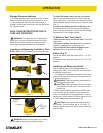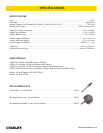
HGE12 User Manual ◄ 7
WARNING: Some dust created by power sand-
ing, sawing, grinding, drilling, and other construction
activities contains chemicals known to cause can-
cer, birth defects or other reproductive harm. Some
examples of these chemicals are:
• Lead from lead-based paints,
• Crystalline silica from bricks and cement and other
masonry products, and
• Arsenic and chromium from chemically-treated
lumber (CCA).
Your risk from these exposures varies, depending on
how often you do this type of work.
To reduce your exposure to these chemicals: work in
a well ventilated area, and work with approved safety
equipment, such as those dust masks that are spe-
cially designed to lter out microscopic particles.
• Avoid prolonged contact with dust from power sand-
ing, sawing, grinding, drilling, and other construc-
tion activities. Wear protective clothing and wash
exposed areas with soap and water. Allowing dust
to get into your mouth, eyes, or lay on the skin may
promote absorption of harmful chemicals.
WARNING: Use of this tool can generate and/or
disburse dust, which may cause serious and perma-
nent respiratory or other injury. Always use NIOSH/
OSHA approved respiratory protection appropriate
for the dust exposure. Direct particles away from
face and body.
WARNING: Always wear proper personal hear-
ing protection that conforms to ANSI S12.6 (S3.19)
during use. Under some conditions and duration of
use, noise from this product may contribute to hear-
ing loss.
CAUTION: When not in use, place tool on its
side on a stable surface where it will not cause a trip-
ping or falling hazard. Some tools with large battery
packs will stand upright on the battery pack but may
be easily knocked over.
Important Safety Instructions for All Battery
Packs
When ordering replacement battery packs, be sure
to include model number and voltage. The battery
pack is not fully charged out of the carton. Before
using the battery pack and charger, read the safety
instructions below. Then follow charging procedures
outlined.
READ ALL INSTRUCTIONS
• Do not charge or use battery in explosive
atmospheres, such as in the presence of am-
mable liquids, gases or dust. Inserting or removing
the battery from the charger may ignite the dust or
fumes.
• NEVER force battery pack into charger. DO NOT
modify battery pack in any way to t into a non-
compatible charger as battery pack may rupture
causing serious personal injury.
• Charge the battery packs only in DEWALT char-
gers.
• DO NOT splash or immerse in water or other liq-
uids.
• Do not store or use the tool and battery pack
in locations where the temperature may reach or
exceed 105°F (40°C) (such as outside sheds or
metal buildings in summer).
DANGER: Electrocution hazard. Never attempt
to open the battery pack for any reason. If battery
pack case is cracked or damaged, do not insert into
charger. Do not crush, drop or damage battery pack.
Do not use a battery pack or charger that has re-
ceived a sharp blow, been dropped, run over or dam-
aged in any way (i.e., pierced with a nail, hit with a
hammer, stepped on). Electric shock or electrocu-
tion may result. Damaged battery packs should be
returned to service center for recycling.
NOTE: Battery storage and carrying caps are pro-
vided for use whenever the battery is out of the tool
or charger. Remove cap before placing battery in
charger or tool.
WARNING: Fire hazard. Do not store
or carry battery so that metal objects can
contact exposed battery terminals. For example,
do not place battery in aprons, pockets, tool boxes,
product kit boxes, drawers, etc., with loose nails,
screws, keys, etc. without battery cap. Transporting
batteries can possibly cause res if the battery
terminals inadvertently come in contact with
conductive materials such as keys, coins, hand
tools and the like. The US Department of Trans-
portation Hazardous Material Regulations (HMR)
actually prohibit transporting batteries in commerce
or on airplanes (i.e., packed in suitcases and carry-
on luggage) UNLESS they are properly protected
from short circuits. So when transporting individual
batteries, make sure that the battery terminals are
protected and well insulated from materials that could
contact them and cause a short circuit.
SAFETY PRECAUTIONS



